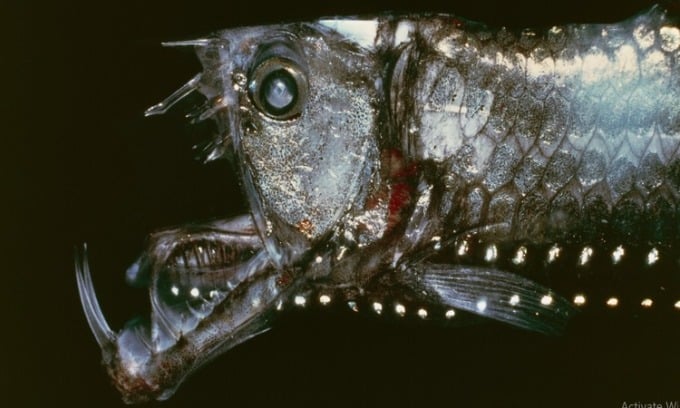Under extreme pressure and temperature, many deep-sea fish species develop strange but useful features that help them hunt and adapt to their environment.

The sharp teeth of a Sloane snakefish. Photo: DeAgostini
Many deep-sea fish look like aliens from horror movies, with their massive teeth, glow-in-the-dark bodies, and bulging eyeballs. But why do they have such strange features?
The bizarre appearance of deep-sea fish largely reflects the extreme environments they inhabit. Much of the ocean's deep waters, which begin 200 metres below the surface, are almost completely dark, have high-pressure systems, have limited food sources and are much colder than other parts of the ocean, with average temperatures averaging just above 4 degrees Celsius.
“The deep sea is a really harsh place to live, so many animals have to adapt to some degree to survive in that environment,” said Mary McCarthy, a fish biologist at the Monterey Bay Aquarium in California.
With few opportunities to find food, deep-sea fish have evolved features that help them catch prey. One of the most formidable features is their jaws. For example, the sloane snakefish ( Chauliodus sloani ) has fangs so large that it cannot close its mouth without piercing its skull. These sharp teeth are also transparent, meaning they can hide their weapons from their prey until it is too late. Other deep-sea fish, such as the pelican eel ( Eurypharynx pelecanoides ), have mouths so large that they take up most of their bodies when stretched out, helping them to catch and swallow the larger fish they find in their environment.
Some predators have a secret weapon that makes them bait magnets: bioluminescence, or the ability to produce their own light. Take the black sea devilfish or anglerfish. They lure prey using a glow-in-the-dark light at the end of an appendage that protrudes from their foreheads, similar to bait on the end of a fishing line. The light attracts prey in part because the marine creatures may assume they are about to eat a small bioluminescent animal.
But luring prey isn’t the only advantage of bioluminescence, which can be found in more than 75 percent of deep-sea fish, according to a 2017 study published in the journal Nature by a team at the Monterey Bay Aquarium Research Institute. Some deep-sea fish, such as the giant hatchetfish ( Argyropelecus gigas) , can dim or brighten their appendages to match the ambient light, using bioluminescence as a stealthy mechanism to ward off potential predators.
“Many other species use this ability to find food, attract mates, and defend themselves against predators,” says Edith Widder, a marine biologist and founder of the Ocean Research and Conservation Association. Widder has participated in hundreds of deep-sea dives to study bioluminescence. In most cases, the light is the result of a chemical reaction in the fish’s body, where a light-emitting compound called luciferin combines with an enzyme called luciferase to produce photons.
Another common feature of the deep sea is its soft appearance. Found in the waters off Australia and Tasmania, the blobfish ( Psychrolutes marcidus ) lives at depths of 600–1,200 m, where the pressure is 100 times greater than at the surface. To survive in such conditions, the blobfish has developed an extremely soft body without a hard skeleton. That's why when the blobfish is brought to the surface, it collapses and turns into a jelly-like creature with a wrinkled face, earning it the nickname " the world's ugliest animal."
An Khang (According to Live Science )
Source link


































































































Comment (0)